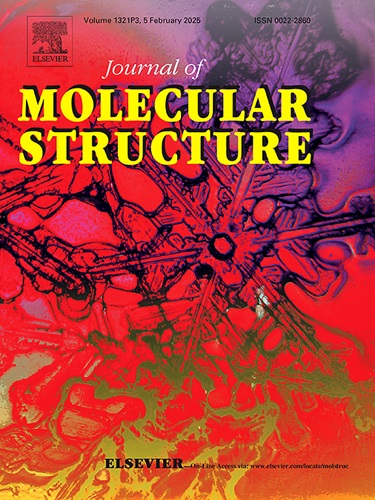Synthesis, characterization and biological activity of Pt(II) acesulfame with triphenylphosphine or bipyridine. Crystal structure, Hirshfield and DFT studies of [Pt(ACS)Cl(PPh3)]
IF 4
2区 化学
Q2 CHEMISTRY, PHYSICAL
引用次数: 0
Abstract
This study presents the synthesis and characterization of two novel platinum(II) complexes incorporating the artificial sweetener acesulfame (ACS) with triphenylphosphine (PPh3) or bipyridine (bipy) ligands. The complexes were synthesized via a straightforward reaction of potassium acesulfamate with [PtCl2(bipy)] and [PtCl2(PPh3)2]. In the case of the triphenylphosphine complex, the reaction yielded two isomers: the major product, [Pt(ACS)Cl(PPh3)2], resulting from the substitution of one chloride ligand by ACS, and the minor product, [Pt(ACS)2(PPh3)2], where both chloride ligands were replaced. The major isomer, [Pt(ACS)Cl(PPh3)2], was characterized in detail using single-crystal X-ray diffraction, revealing a distorted square planar geometry around the platinum center. Further analysis of this complex included Hirshfeld surface analysis to investigate intermolecular interactions and enrichment ratios, as well as Density Functional Theory (DFT) calculations to explore its electronic properties, including HOMO-LUMO energy levels and charge distribution. In addition, the antibacterial activity of acesulfame and its complexes was examined against Pseudomonase aeroginosa and Staphylococcus aureus. The data showed that the metal complexes are more active than the free artificial sweetener acesulfame. Also, the complex [Pt(ACS)2(bipy)] has the highest activity against bacteria species.
三苯基膦或联吡啶对乙酰磺化铂的合成、表征及生物活性研究。[Pt(ACS)Cl(PPh3)]的晶体结构、Hirshfield和DFT研究
本研究介绍了两种新型铂(II)配合物的合成和表征,该配合物将人工甜味剂乙酰磺胺(ACS)与三苯基膦(PPh3)或联吡啶(bipy)配体结合。这些配合物是由乙酰磺酸钾与[PtCl2(bipy)]和[PtCl2(PPh3)2]直接反应合成的。在三苯基膦配合物的情况下,反应产生两个异构体:主要产物[Pt(ACS)Cl(PPh3)2],由ACS取代一个氯配体产生,次要产物[Pt(ACS)2(PPh3)2],其中两个氯配体都被取代。主要的同分异构体[Pt(ACS)Cl(PPh3)2]通过单晶x射线衍射进行了详细的表征,揭示了铂中心周围扭曲的方形平面几何形状。对该配合物的进一步分析包括Hirshfeld表面分析,以研究分子间相互作用和富集比,以及密度泛函理论(DFT)计算,以探索其电子性质,包括HOMO-LUMO能级和电荷分布。此外,还研究了乙酰磺胺及其配合物对铜绿假单胞菌和金黄色葡萄球菌的抑菌活性。结果表明,金属配合物比游离人工甜味剂安赛蜜活性更高。此外,复合物[Pt(ACS)2(bipy)]对细菌种类具有最高的活性。
本文章由计算机程序翻译,如有差异,请以英文原文为准。
求助全文
约1分钟内获得全文
求助全文
来源期刊

Journal of Molecular Structure
化学-物理化学
CiteScore
7.10
自引率
15.80%
发文量
2384
审稿时长
45 days
期刊介绍:
The Journal of Molecular Structure is dedicated to the publication of full-length articles and review papers, providing important new structural information on all types of chemical species including:
• Stable and unstable molecules in all types of environments (vapour, molecular beam, liquid, solution, liquid crystal, solid state, matrix-isolated, surface-absorbed etc.)
• Chemical intermediates
• Molecules in excited states
• Biological molecules
• Polymers.
The methods used may include any combination of spectroscopic and non-spectroscopic techniques, for example:
• Infrared spectroscopy (mid, far, near)
• Raman spectroscopy and non-linear Raman methods (CARS, etc.)
• Electronic absorption spectroscopy
• Optical rotatory dispersion and circular dichroism
• Fluorescence and phosphorescence techniques
• Electron spectroscopies (PES, XPS), EXAFS, etc.
• Microwave spectroscopy
• Electron diffraction
• NMR and ESR spectroscopies
• Mössbauer spectroscopy
• X-ray crystallography
• Charge Density Analyses
• Computational Studies (supplementing experimental methods)
We encourage publications combining theoretical and experimental approaches. The structural insights gained by the studies should be correlated with the properties, activity and/ or reactivity of the molecule under investigation and the relevance of this molecule and its implications should be discussed.
 求助内容:
求助内容: 应助结果提醒方式:
应助结果提醒方式:


